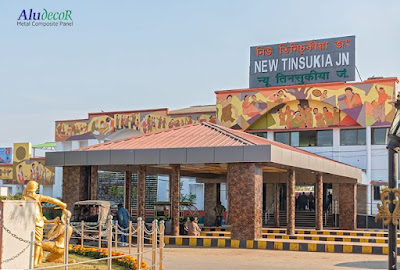Essential Tips for Successful ACP Sheets Cladding at Railway Stations
Railway stations, serving as gateways to different destinations, are more than just functional hubs; they are also a reflection of a region's aesthetics and spirit. More than that, it offers an emotional connect. Whether you are returning to your hometown after a year, or visiting your bucket-listed holiday destination – a sneak peek of the railway station before actually arriving gives a wobbly feeling out of excitement. We are sure you know your station from miles before it arrives!
A structure that holds so much importance in everyone’s life should be carefully built. As much as it is important to follow the railway guidelines and protocols, it should also have a nice aesthetic appearance. After all, building a railway station is not an everyday affair. When it comes to cladding railway stations, the selection of materials and their installation methods play a pivotal role. Let’s find out in this blog why ACP board design is a wise choice for railway stations and how to choose the right one for cladding.
Design and Planning: Blending Aesthetics with Landscape
The design and planning phase is like the canvas upon which the railway station's visual is painted. A proper selection of colours and styles of the aluminum sheet design can complement the local landscape and culture, creating a harmonious coexistence. For instance, when renovating a railway station in the vibrant state of Rajasthan, one can opt for ACP panels from the "Sand" series by Aludecor. These panels not only bring the essence of the region into focus but also blend seamlessly with the state's aesthetics.
Material Selection: Reflecting Shine Amidst Pollution
Railway stations, by virtue of its functionality, face the daily onslaught of pollution. Material selection is crucial to maintain the gloss and vibrancy of the cladding. The choice of ACP thickness and the coil's paint quality can significantly impact the longevity of the shine. Aludecor uses paints from reputable manufacturers such as PPG, Akzonobel etc. to ensure that the station retains its bright and aesthetically pleasing appearance even in challenging environmental conditions.
Surface Preparation: The Precursor to Perfection
Before the cladding installation process begins, surface preparation is essential. Fabricators undertake thorough cleaning of the surfaces for aluminium sheet design to remove any contaminants, ensuring that the aluminum sheet design can be made perfectly. This step is pivotal in guaranteeing that the ACP panels adhere effectively and maintain their visual appeal over time.
Fixing Method: The MFR System Advantage
The installation of ACPs on any structure, using the Aludecor Male Female Rainscreen System (MFR), is a smart choice for several reasons. This system consists of Male and Female 6063-T6 aluminum alloy profiles, and it's designed for assembling composite panels on ventilated facades.
- Versatile and Customizable: The MFR system is versatile and can be customized to fit the specific requirements of your project. This means it can adapt to a variety of structures and designs, making it suitable for a wide range of applications.
- Concealed Fixing: The MFR system employs a concealed fixing method. This means that the fasteners used to secure the composite panels are hidden from view. This not only enhances the visual appeal of the structure but also provides a sleek and seamless appearance.
- Ventilated Facades: The MFR system is specially designed to construct ventilated facades. Ventilated facades have an open space between the cladding and the building's structure. This space allows for proper airflow and ventilation, which can help regulate temperature and moisture, thereby improving the overall durability of the installation.
- Aluminum Substructure: The substructure of the MFR system is made entirely of 6063 T6 aluminum profiles. Aluminum is known for its corrosion resistance, which is a critical factor in ensuring the longevity of the installation. It's also lightweight, making it easier to handle during installation.
- Vertical Mullions: Omega-shaped vertical mullions play a crucial role in the MFR system. They provide additional structural support, further enhancing the durability of the ACP installation.
Maintenance Guidelines: Easy Care for Timeless Elegance
Maintaining the visual appeal of ACP-clad railway stations need not be a daunting task. The panels of ACP board design are easy to clean and require minimal maintenance. Railway stations that use ACP cladding can benefit from the material's relatively smooth and non-porous surface, making it easier to clean off dirt and grime. ACP cladding resists the accumulation of dust, pollution, and other environmental contaminants, which can be a common issue in outdoor structures like railway stations. Regular cleaning can be performed using a mild detergent, water, and a soft brush or cloth to wipe away surface dirt and stains. Additionally, the simple aluminium sheet design is weather-resistant and it reduces the impact of natural elements that make maintenance more manageable. This ease of cleaning and maintenance can help keep railway stations looking clean and attractive for passengers and visitors.
Bottom line
Selecting the right ACP board design for cladding at railway stations is a new-age design choice. It can achieve a harmonious blend of aesthetics, durability, as well as low maintenance. Aludecor stands as the premium choice, offering a wide range of ACP panels and an unmatched commitment to quality. By following the guidelines mentioned above and choosing Aludecor, railway stations can make a lasting impression as welcoming passengers to their respective regions, reflecting their unique spirit and character. Elevate your railway station's appeal with Aludecor ACP panels, where aesthetics and longevity come together seamlessly.




Comments
Post a Comment